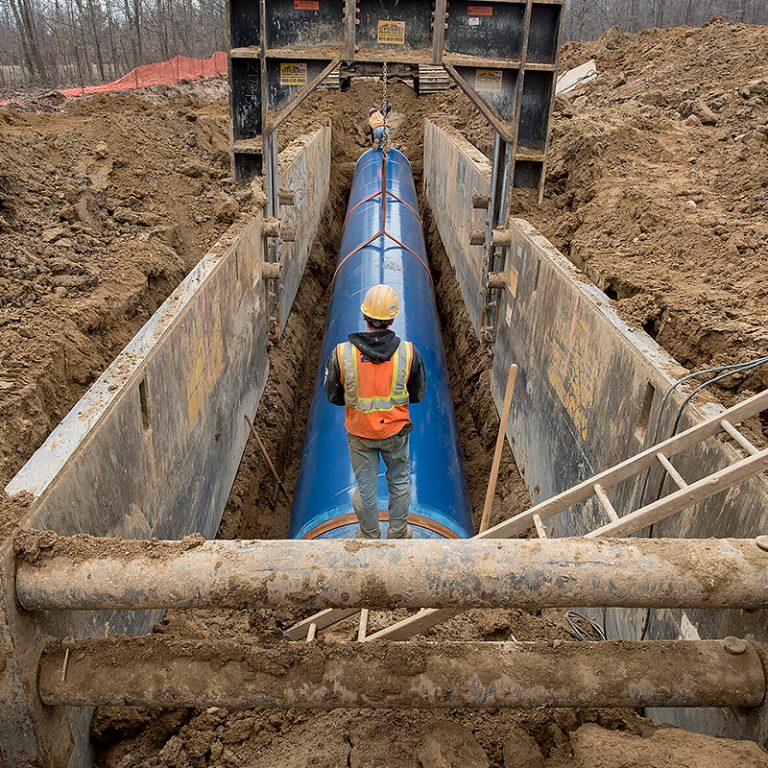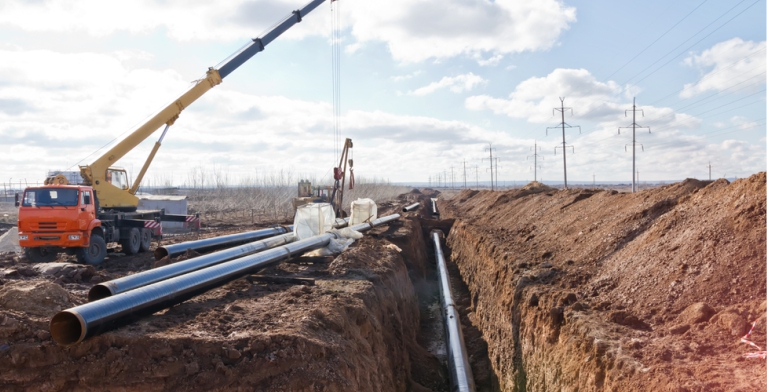Success Begins With Proper Creek Pipe HDPE installation
Comprehending the Fundamentals of Pipes Installation: What You Required to Know About the Process
Correct pipe installation is important for any type of pipes system. It calls for careful factor to consider of numerous variables, consisting of product selection and adherence to local policies. A tactical format can prevent issues like pressure loss, while the right devices assure effective joining techniques. However, also experienced installers can make common errors. Understanding these essentials can lead to an extra reliable and resilient system, prompting a closer look at the crucial elements included in the process.
Selecting the Right Products for Pipe Installation
When considering pipe installation, the selection of appropriate products is necessary to making sure durability and capability. Different products are offered, each offering special advantages and considerations. PVC pipelines are light-weight, immune to rust, and cost-efficient, making them perfect for residential pipes. Conversely, copper pipelines, known for their durability and capacity to withstand high temperature levels, are usually preferred for heating systems.Additionally, galvanized steel pipelines provide stamina and longevity, appropriate for durable applications, although they are at risk to rust over time.For underground installments, polyethylene pipelines are preferred due to their flexibility and resistance to tension splitting. Appropriate material selection depends on the details needs of the task, including stress scores, temperature variations, and the chemical nature of the liquids being transferred - Creek Pipe reviews. Eventually, informed choices concerning pipe materials contribute significantly to the general success and longevity of pipes systems
Understanding Local Building Ordinance and Regulations
Exactly how can comprehending local building ordinance and regulations impact pipe installation? Experience with these codes is crucial for ensuring that pipe installments are risk-free, certified, and reliable. Regional structure codes outline certain needs regarding products, installation strategies, and security steps, which need to be complied with in order to prevent potential legal concerns and expensive fines.Failure to abide can lead to evaluations being fallen short, hold-ups in job conclusion, and even mandated elimination of poorly mounted pipes. On top of that, recognizing zoning legislations and policies can influence the kind of materials permitted, in addition to the techniques used for installation.Contractors and homeowners alike need to spend time in assessing regional laws prior to beginning any installation job. This positive method not only promotes safety but additionally boosts the general high quality and toughness of the pipes system, inevitably promoting long-lasting performance and satisfaction.
Preparation Your Pipe Design and Layout
Correct planning of pipe format and style is crucial for achieving an effective pipes system. This procedure starts with assessing the certain demands of the area, thinking about the area of fixtures and devices. Exact measurements ensure that pipelines are properly directed, decreasing bends and turns that can cause press loss.Consideration of the circulation rates and the sorts of products used is essential, as various materials have varying durability and compatibility with plumbing systems. Additionally, the developer should account for future growths or adjustments to the design, permitting for adaptability in instance of renovations.Efficient water drainage and ventilation are also significant elements of the layout, as they stop blockages and guarantee appropriate waste removal. Lastly, cooperation with neighborhood building codes ensures conformity and security, which is paramount in any type of plumbing installation project.
Essential Tools and Devices for Installation
Effective pipe installation pivots on having the right devices and equipment handy. Essential devices include pipe cutters for tidy cuts, wrenches for tightening installations, and pliers for gripping and transforming pipes. Furthermore, a level assurances pipes are set up equally, while a measuring tape help in achieving accurate lengths.For particular materials, a blowpipe might be needed for copper pipes, while a PVC cutter is important for plastic choices. Security devices, such as handwear covers and goggles, shields installers from prospective hazards throughout the process.A pipe bender can be specifically useful for developing smooth contours without endangering integrity, while a torque wrench assurances that links are protected to the manufacturer's specifications.Having these tools conveniently available not just facilitates a smoother installation process however advice also adds to the overall durability and functionality of the plumbing system. Correct equipment is critical in accomplishing resilient results.
Methods for Proper Pipe Joining and Securing
Attaining a secure and leak-free connection in between pipes requires cautious focus to joining and sealing strategies. Various techniques exist, each matched to various pipe materials and applications (Creek Pipe roustabout). For instance, welding is commonly used for metal pipelines, ensuring robust links via warmth blend. On the other hand, plastic pipes gain from solvent concrete or blend welding, developing strong, permanent bonds.Threaded connections prevail in both steel and plastic piping, needing specific positioning and using appropriate sealers, such as Teflon tape or pipe dope, to prevent leakages. Compression fittings provide another option, where mechanical pressure safeguards the pipes with each other, making them conveniently dismantled for maintenance.Regardless of the method picked, appropriate preparation is vital. This consists of cleansing pipe finishes and guaranteeing they are complimentary from debris. Executing these strategies carefully will enhance the long life and integrity of the pipe system, ultimately contributing to its efficient efficiency
Typical Mistakes to Avoid Throughout Installation
Throughout pipe installation, staying clear of common blunders is vital for guaranteeing a dependable and reliable system. One constant mistake is falling short to measure and cut pipelines accurately, which can cause improper fittings and leaks. In addition, neglecting to examine the compatibility of products can cause corrosion or various other damages over time. Incorrectly protecting joints and links can likewise create powerlessness in the system, creating potential failures.Another common error is forgeting the importance of incline and water drainage; pipelines should be installed at the proper angle to help with proper flow. Insufficient assistance for pipes can cause sagging and anxiety, affecting the integrity of the system. Inevitably, overlooking local codes and guidelines can result in pricey rework and safety and security risks. By knowing these risks, installers can significantly boost the durability and performance of pipe systems.
Maintenance Tips for Resilient Pipe Equipments
To assure the long life of pipe systems, routine evaluations and cleaning are vital methods. These measures assist recognize prospective issues prior to they intensify right into significant troubles. In addition, using correct insulation strategies can further safeguard pipelines from temperature level variations and environmental variables.
Normal Examinations and Cleaning Up
Normal assessments and cleaning are crucial for preserving the Go Here long life and effectiveness of pipe systems. Consistently examining pipelines for signs of corrosion, leakages, or clogs can assist determine potential issues before they intensify into expensive repair work. Cleansing pipelines occasionally removes buildup that can restrict circulation and advertise degeneration. It is a good idea to schedule examinations a minimum of when a year, but more regular checks may be needed in high-usage environments. Utilizing specialist solutions for extensive cleansing guarantees that all debris is successfully cleared. In addition, keeping documents of examinations and maintenance activities aids in tracking the system's health and wellness gradually - Creek Pipe trenching services. By focusing on these practices, homeowner can enhance the dependability and life-span of their pipe systems
Correct Insulation Techniques
Reliable insulation techniques play a necessary role in preserving the performance and durability of pipe systems. Proper insulation decreases heat loss in warm water pipes and protects against freezing in chilly water pipelines, substantially lowering power expenses and possible damages. Common materials utilized for insulation include fiberglass, foam, and rubber, each offering differing levels of thermal resistance. It is important to guarantee that insulation is used uniformly, covering all revealed areas without voids. Additionally, protecting insulation with ideal bolts aids maintain its setting and performance in time. Routine assessments should be carried out to identify damage, ensuring timely substitutes. By applying these methods, pipe systems can run efficiently and have a prolonged solution life, eventually profiting both the setting and the property owner.

Regularly Asked Questions
How Do I Identify the Appropriate Pipe Size for My Project?
Determining the suitable pipe size involves evaluating the task's circulation needs, pressure specifications, and the sort of liquid being moved. Consulting layout standards and conducting calculations assurances perfect performance and effectiveness in the installation procedure.
What Are the Environmental Effects of Different Pipe Products?

Can I Install Pipes Myself or Should I Work with a Professional?
The question of whether to install pipelines independently this page or hire a specialist usually depends upon the individual's skill degree and task intricacy. An expert may guarantee compliance with regulations and lower prospective lasting problems.

How Much Time Can I Expect My Pipe Installation to Last?
The long life of pipe installation varies significantly, generally lasting 20 to 100 years, relying on products, installation quality, and maintenance. Normal examinations and proper care can improve durability and stop early failings.

What Are the Indications of a Failing Pipe System?
Signs of a stopping working pipe system include frequent leakages, unusual water stress adjustments, tarnished water, mold development, and persistent wetness. Home owners must monitor these indications to avoid pricey damage and warranty timely fixings are made.